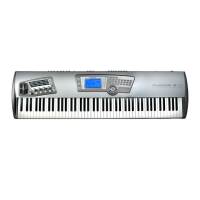ALESIS FUSION
ANALOG SYNTHESIS TUTORIAL
More recently, many LFOs allow their rate to
be controlled by some other controller. For
example, you could control
LFO rate with velocity so that playing the keyboard hard will make
the LFO rate faster and
vice versa
... playing softer yields a slightly slower
LFO rate. Or it could
be controlled by another LFO or envelope generator a real-time controller (see below)...
endless possibilities
A few synths allow the ‘shape’ or symmetry of the LFO’s waveforms to be
altered as well for
even more control flexibility.
Fusion allows all of these and more but that’s probably enough to be going on with for now!!!
Sample & Hold
This is another old module from
the early days and it falls somewhere between being a
controller and a control
processor
.
Basically, it takes an incoming control signal, ‘samples’ it
9
and produces a stepped
output
according to the rate of the clock:
Here, with a slowly rising control input signal, we get a rising stepped
output which, if
connected to pitch, would give us a kind of arpeggio effect. This is how they all relate:
The S&H processor takes
(‘samples’) the level of the incoming signal at each clock pulse and
holds that value for the duration of the clock step whereupon it takes the value
of the incoming
signal at the next clock pulse and holds that level and so
on. So, in this case, the signal is low
at the first clock pulse so the output is held low until the next clock pulse.
At that point, the
input signal is higher
so that level is sampled and held. At the next pulse, the input is slightly
higher so that is held but at the next pulse, the input signal is lower as is the output level... etc..
9 This is not to
be confused with ‘sampling’ audio signals for use in a sampler. Although the
principles are actually the same, the sample & hold unit’s clock is operating at sub-audio
frequencies/rates and is thus for control purposes only.
Controllers
Page
32

